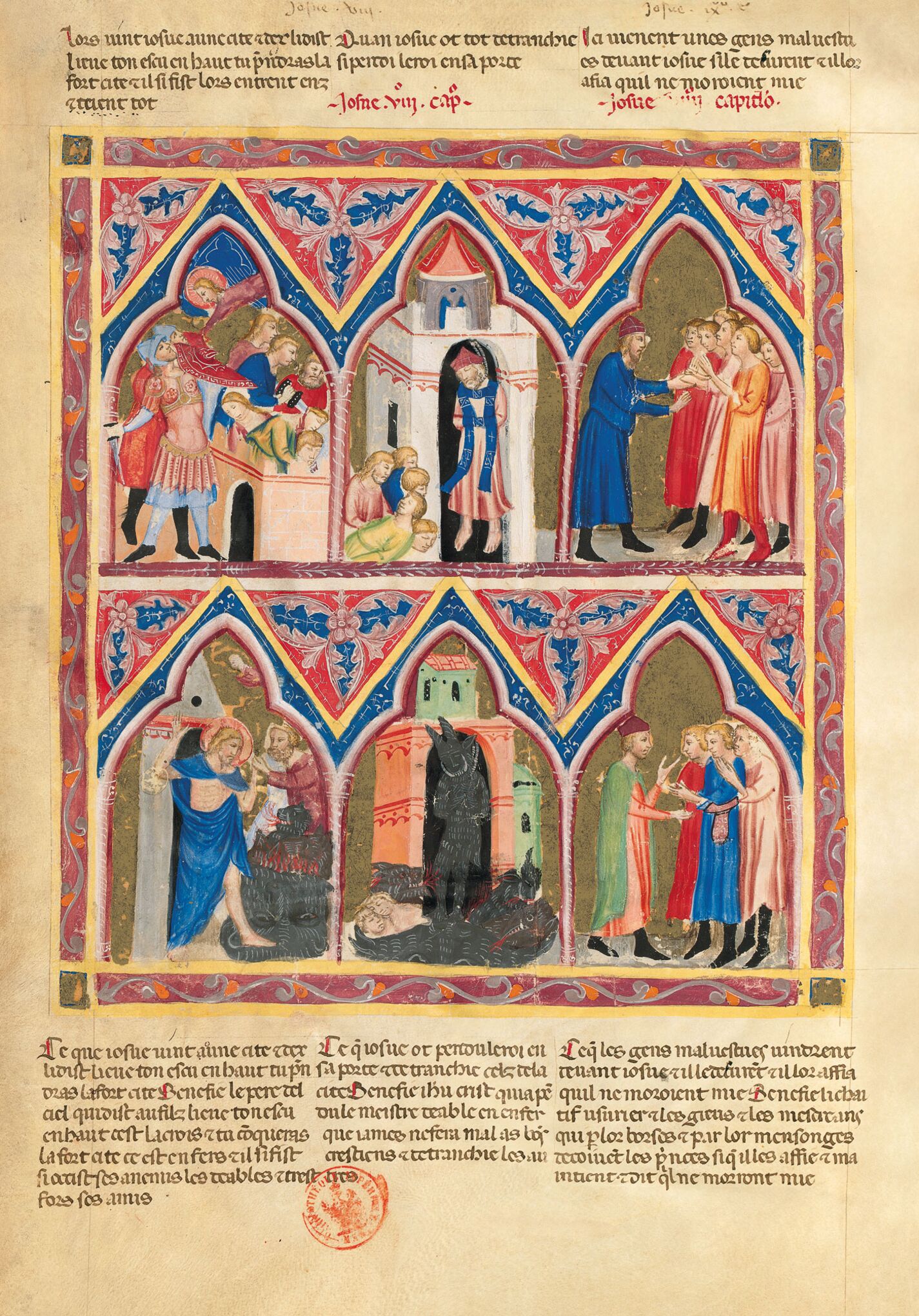“Then Joshua comes to a city and God tells him raise your shield up and you will take the fortified city and he did. Then they enter [and kill everything corrected by expunction]. When Joshua had destroyed everything he hung the king in his gateway. Here come badly-dressed people to Joshua and deceive him and he swore they would not die.”
The capture of the city of Ai, the massacre of all its inhabitants and the hanging of their king in the gate of his palace in the first two arches are yet another indication of the freedom with which the canonical text of the Bible is interpreted in our manuscript. The king of Ai hung from a tree in the Vulgate is hung in this instance in the gateway of his city or palace. More surprising is God’s order to Joshua to raise his buckler above his head: a magical gesture or ritual enabling him to capture the fortified city and slaughter all its inhabitants. The massacre is portrayed correctly and we do not understand why the gloss describing these killings was eliminated by expunction by the corrector. This transposition of the Vulgate paves the way for the moralisation image. Joshua raising his buckler aloft signifies Christ who, upon God’s order, erects the cross (left out by the miniaturist) in order to conquer hell where he kills the demons and frees his friends, “hold your shield aloft that is the cross, and you will conquer the fortified city that is hell”. The moralisation image portrays the descent into hell by the risen Christ, but without his cross, a transposition of Joshua’s shield.
The king of Ai also had to be hung in a city gateway to lead to the devil being hung in a gateway to hell in the moralisation image. The inhabitants of Ai put to the sword are, of course “the others”, i.e. those who are not good Christians. The third picture depicts Joshua with his close neighbours the Gibeonites in rags and starving as if they had travelled a long way to see him. This poorly dressed group save their lives by deceiving Joshua who slaughters everything in his path, both man and beast. These people in tatters (but decently dressed in the picture) signify “the miserable usurers”, Jews and infidels “who with their purse and lies deceive the princes who help and keep them”, i.e. who deceive princes with bribery and lies to save their lives without mending their ways.
Yves Christe
University of Geneva
Marianne Besseyre
Illuminated Manuscripts Research Center, Bibliothèque nationale de France
Fragment of the Bible moralisée of Naples commentary volume

“Then Joshua comes to a city and God tells him raise your shield up and you will take the fortified city and he did. Then they enter [and kill everything corrected by expunction]. When Joshua had destroyed everything he hung the king in his gateway. Here come badly-dressed people to Joshua and deceive him and he swore they would not die.”
The capture of the city of Ai, the massacre of all its inhabitants and the hanging of their king in the gate of his palace in the first two arches are yet another indication of the freedom with which the canonical text of the Bible is interpreted in our manuscript. The king of Ai hung from a tree in the Vulgate is hung in this instance in the gateway of his city or palace. More surprising is God’s order to Joshua to raise his buckler above his head: a magical gesture or ritual enabling him to capture the fortified city and slaughter all its inhabitants. The massacre is portrayed correctly and we do not understand why the gloss describing these killings was eliminated by expunction by the corrector. This transposition of the Vulgate paves the way for the moralisation image. Joshua raising his buckler aloft signifies Christ who, upon God’s order, erects the cross (left out by the miniaturist) in order to conquer hell where he kills the demons and frees his friends, “hold your shield aloft that is the cross, and you will conquer the fortified city that is hell”. The moralisation image portrays the descent into hell by the risen Christ, but without his cross, a transposition of Joshua’s shield.
The king of Ai also had to be hung in a city gateway to lead to the devil being hung in a gateway to hell in the moralisation image. The inhabitants of Ai put to the sword are, of course “the others”, i.e. those who are not good Christians. The third picture depicts Joshua with his close neighbours the Gibeonites in rags and starving as if they had travelled a long way to see him. This poorly dressed group save their lives by deceiving Joshua who slaughters everything in his path, both man and beast. These people in tatters (but decently dressed in the picture) signify “the miserable usurers”, Jews and infidels “who with their purse and lies deceive the princes who help and keep them”, i.e. who deceive princes with bribery and lies to save their lives without mending their ways.
Yves Christe
University of Geneva
Marianne Besseyre
Illuminated Manuscripts Research Center, Bibliothèque nationale de France
Fragment of the Bible moralisée of Naples commentary volume